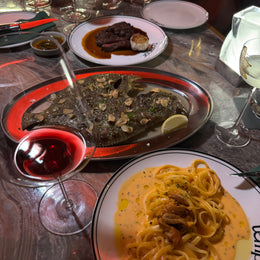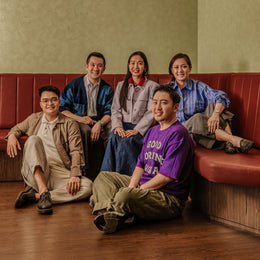
You've heard of food and wine pairings; and perhaps, food and sake pairings. However, have you heard of wine and sake pairings within the same course?
![]()
Ki Teppan & Rogama. Source: Ishinomaki Group

Ishinomaki Group specialises in pairing food and great sake together: having done 120 unique food pairings within the past four years! Helmed by in-house sake sommelier Janice Chi and head chef Chi Pin Han, the group first started with the Ishinomaki restaurant, before expanding to a teppanyaki restaurant, Ki Teppan & Ragome, and recently, Setsuri; the grill izayaka concept that specialises in shochu.

Lots of care was taken to ensure the wines and sakes were served at the right temperature - the setup at Ki Teppan & Rogama lets you observe the chefs hard at work to make the evening happen.
The idea for this pairing was a year in the making: one day, Janice Chi and Lungarotti's Export Manager and Marketer Marco Rossi were having some dinner over and sake and wine, and in a booze-fuelled brainstorm session, conceptualised the sake-wine-food pairing idea. This was a step up from the usual, as Janice herself said: the struggle to pair both wine and sake within the same course is that wines are much more intense in character that could drown out the subtler rice counterpart.

The full range of Lungarotti's wines and Janice's selection of sakes!
Nevertheless, Janice took on the challenge, and added another permutation to the mix: only serving hot sake during the course. Fast forward to recently, and we had the chance to try out this pairing session! Janice also shared that usually, it was Chef Chi who would cooked up dishes which Janice would then find a sake suitable to pair with - but this time round, Janice called the shots for the dishes to fit the wines and sakes.

Janice (right) and Marco (left) took turns to lead the pairings at the night went on.
Joined with us was also Marco himself, who introduced the wines for the session. We have been served an eight course pairing, featuring four wines from Lungarotti and four sakes from various sake breweries. We'll be writing a short review of the alcohol served as is (we'll make a separate review for Lungarotti's wines soon!), followed by our impressions when paired with the dish served.
Let's get to this double pairing!
Wine Review: Lungarotti Pinot Grigio Umbria Bianco IGT 2019
The first course was the Lungariotti Pinot Grigio Umbria Bianco IGT 2019, paired with bluefin tuna tartare that is seasoned with aged balsamic vinegar, extra virgin olive oil, and a touch of wasabi.

The Wine
On the nose, the wine is floral and dainty at first, but grows in intensity. Fresh, juicy aromas surface later on, taking a more citrus and tart character of freshly squeezed lemon juice, lime juice, lime zest and gooseberries. On the palate, the wine is big, juicy and fresh, starting out tart and becoming fruitier and sweeter, with a floral hint. It then finishes of with the same tartness, with a slight saline character and vegetal aromas.
This Pinot Grigio is rich in all the right ways - big, juicy, and bright, without feeling too steely or sharp in its acidity. What I particularly liked was the goral and fruit notes that you get throughout the tasting. In general, this Pinot Grigio has great intensity that still sticks to being refreshing with a pleasant tartness.
Paired With Bluefin Tuna Tartare

Wow! With the wine, the fruitier, sweeter flavours of balsamic vinegar is drawn out of the tartare, which then intermingles with the savoury-sweet fishiness of the tuna tartare. At the same time, the tune tartare also draws out the sweeter, fruitier flavours of the wine, where that orange spritz note coupled with the white flowers gets more intense.
The shisho shreds garnished on the tartare also gives a lift to the greener flavours of the wine, whilst keeping the overall flavours and aromas fresh. And lastly, the umami of the tuna fits into the pairing like a missing piece of the puzzle. Fantastic start!
Sake Review: Ryusei Ryofu Nama Nama Kimoto Junmai Ginjo (35°C)
For our first sake pairing, the Ryusei Ryofu Nama Nama Kimoto Junmai Ginjo is paired with Simmered Iberico Pork Belly with White Radish.

The Sake
The aromas of the sake was nutty, with a natto-dashi like umami fragrance at first. Then, a porcini broth like fragrance emerges to the top, with fermented brown bean condiment taking over. The palate was sweet and savory at the same time - a slightly sweetened soup of white miso, soy sauce and mirin, followed by a mild fishy flavour of bonito flakes, and then finishing off with a rather lactic tang which develops into a sweetcorn-like sweetness.
What intrigued me the most was that sweetcorn flavour that shines through in the finish, strong, sweet, juicy, whilst the lactic acid gave the sake an airy, light quality that lifted its other savoury elements. For that sweetcorn flavour alone, this sake is really worth trying warm!
Paired With Simmered Iberico Pork Belly with White Radish

The warm, umami and lactic notes of the sake cleaves through that rich, rendered and melt in your mouth fat, giving a satisfying medley of flavours that draws out that inherent sweetness in the pork. The fleshy, rooty sweetness of the radish, coupled with the sweetcorn juiciness of the sake, really combines into an intense, satisfying and filling sweetness overall.
I really appreciate how the broth is lightly seasoned, which allowed for the umami notes of the sake to really shine through. To reset the palate, the mustard gave a much needed spicy freshness that keeps you going for more.
Wine Review: Lungarotti Bianco Di Torgiano DOC Torre Di Giano Vigna Il Pino 2019
The Torre Di Giano Vigna Il Pino was named after a pine tree in the middle of the vineyard. This is Lungarotti's premium single vineyard white, where three grapes are used, as described by Marco: Trebbiano gives the body and structure of the wine (much like a tree trunk), the Grechetto is the "fruits" of the tree, and Vermentino are the "leaves and foilage" of the tree.
![]()
Lungarotti Vineyard. Source: Profile Wine Group
As a nod to the Burgundian style of wines, this Torre Di Giano wine was also one of Italy's first white wines to be aged in oak.
The wine was paired with Hokkaido Ginpo (Tidepool Gunnel) with Citrus Beurre, Blanc Sauce and Granny Smith Apple Shreds.

The Wine
On the nose, the wine was dense, rich and filled with stone fruits; with some cultured butter aromas intermingling. Upon subsequent nosings, a very mild, freshly grated nutmeg aroma was expressed. Texturally, there's a creaminess through the wine, with a prominent tart acidity of gooseberries and underripe peaches, with a subtle elderflower fragrance at the back palate. The wine finishes off with a slightly spicy flavour of baking spices with some greenness of fresh spinach and cabbage.
The wine is nuanced and layered, at first practicing restraint but grows in intensity and complexity in the glass. In particular, I really like the spicy oakiness that this wine has - it really feels like a robust constant that stands as a scaffolding to the other gentler, sometimes subtle fruit and green flavours.
Paired With Hokkaido Ginpo with Citrus Beurre, Blanc Sauce and Granny Smith Apple Shreds

The creaminess of the ginpo really brings out the nutmeg flavour of the wine, almost as if the wine's oaky flavours is acting as a seasoning here! The grilled fish flesh, together with the granny smith apple shreds, teases out that very subtle elderflower flavour and aroma out of the wine as well, elevating it beyond the stronger peach and nectarine flavours. The subtle yuzu in the sauce was a great touch as well, offering an element of citrus that sometimes feel missing in the dish, but mild enough that it only serves to freshen up the pairing slightly. Truly quite sublime!
Wine Review: Lungarotti Sagrantino di Montefalco DOCG 2019
This wine was paired with Shark Skin Flounder Braised with Haccho Miso, Pumpkins, Carrots and Grated Ginger. The carrots and pumpkin was deliberately cooked light to showcase the miso.

The Wine
On the nose, this wine was deeply powerful, with much tannic and smoky character, along the elements of rosewood and sandalwood, with a spicy cinnamon accompanied by dark cherry compote. On the palate, the wine starts subtle at first with red fruits of cherries and strawberries, but grows in astringency and complexity -black tea, star anise, black plum skins and tobacco leaves. The wine finishes off with a blend of baking spices and sweet tea.
This wine does dial up everything to ten! The strong tannins, spice and dark fruits have an equally strong intensity, where despite the strength of the aromas and flavours, still maintains an appreciable balance. My favourite part of the wine is that complex blend of sweet spices!
Paired With Shark Skin Flounder Braised with Haccho Miso, Pumpkins, Carrots and Grated Ginger

The flaky, dense and lean texture of the fish soaks up the tannins, scrubbing the palate clean. The grated ginger was a welcome addition, giving a fresh pop to the wine, uplifting the denser heavier dark fruit flavours to be more vibrant and lively. The really subtle but pleasant intermingling of flavours is where the earthy sweetness of the pumpkin and carrot in the sauce interacts with the plummy, dark stone fruit flavours of the wine, tempering the stalky tannins slightly and giving a full sweetness to the pairing.
This pairing reads a tale of contrast, where opposing elements of the wine and dish reveal elements of each other in an intriguing way. On that note, the overlap of sweet spices is really enjoyable, giving the wine and dish something in common to build upon!
Sake Review: Yoshinosugi No Taruzake Omachi Yamahai Junmai (35°C)
![]()
Source: Japan Taste
This sake was paired with Deep Fried Shrimp with Kakinotane Powder and Sansho Salt. Kakinotane Powder is made by crushing the ironic crescent shaped flavoured rice snack Kakinotane (柿の種).

The Sake
The sake had strong bamboo stem and barrel aromas at first, which then becomes less woody and more green with some development. The palate reflects the nosing, being mostly woody and savoury; with a delicate sweetness of water chestnuts, boiled peanuts and a spicy kick of white pepper. The finish is light and cleansing, reminiscent of shabu shabu broth, with a lemony flavour of hinkoi, alongside the grassiness of lemongrass and herbal sweetness of chrysanthemum leaves (tang oh).
Whilst overall quite woody, the sake was by no means overbearingly stemmy or green. There is an interesting deliciousness from the herbaceous lemony flavours of lemongrass, mitsuba and chrysanthemum leaves, and when accentuated by the light savouriness of the dashi-esque umami, makes for a great clean sake to build flavours on.
Paired With Deep Fried Shrimp with Kakinotane Powder and Sansho Salt

The cereal flavour of the batter and the sansho salt really compliments and add to the woodier, bamboo flavours of the sake, that when intermingled together, creates a fried buckwheat, popcorn like flavour on the palate! There is also a whole host of fried-nutty snack flavours, like chickepea fritters (muruku) and party-pack snacks. The use of prawn was very apt - the sweetness of the crustacean meat, coupled with the white pepper spice. Quite a novel paring!
Wine Review: Lungarotti Dulcis Vino Liquoroso
Marco noted that this fortified wine was made mostly with Trebbiano grapes, giving the fortified wine a high amount of acidity. This wine is especially popular during the festive season at the end of the year.
The DULCIS Vino Liquoroso was paired with 62°C Duck Breast , Persimmon, Walnuts and Miso Vinegar Dressing. Chef Chi noted that he deliberately chose slightly underrie and hard persimmons for this dish.

The Wine
On the nose, a whole bouquet of dried and candied foods: marzipan and hazelnut cream, followed by floral notes of orange blossoms, white raisins, and candied orange peels. The palate reads a basket of dried tropical fruits, followed up with sweet-spicy flavour of candied ginger and the floral nuttiness of dried figs. The wine ends with sweet citrus fruits at first, with the light nuttiness making a return, ending of with the drying spice of mace.
The flavours are intense and unashamedly sweet, but there is great tension in the form of its high acidity. You get a whole host of candied fruits, nuts and floral flavours, yet, with its acidity, it never feels cloying or overbearing. Truly good stuff!
Paired With 62°C Duck Breast , Persimmon, Walnuts and Miso Vinegar Dressing

The flavours give the impression of autumn in a pairing! The nutty, sweet and dessert flavours of the wine livens up the heavily stewed sauce and the lean meatiness of the duck. The pairing feels like classic duck and orange sauce, but here, the earthiness of the pumpkin and carrots really draws out the baking spice and nutty flavours of the wine.
I really appreciate that the duck fat is tempered with the use of slightly underripe persimmon, binding the wine and the dish together with a much needed astringency that tempers the richness of both. Outstanding pairing, and perhaps, my favourite of the wine pairings!
Sake Review: Moriki Yamahai Rie Style Tokubetsu Junmai (40°C)
Janice had purposely picked a masculine style sake for this pairing, which was Mount Fuji White Salmon, Shio Koji White Salmon and Salmon Roe Sushi. Chef Chi squeezed the ikura out slightly, using the juices are used to brush over the fish for an accentuated sweet-fishy aroma.

The Sake
On the nose, the sake reads cooked rice, rice flour and glutinous rice syrup. As it sits, dried apricots and peach aromas start to develop, tempering the rice fragrance slightly. The sake is bold, muscular and drying on the palate, starting off with yakionigiri or roasted rice crackers, followed by the leafy aroma of bamboo leaf and ginko nuts, then cut through by a dry-lactic flavour of kefir and set yoghurt. The finish is more lactic with a growing dryness of white pepper, cracked peppercorns and tea tree mushrooms.
This sake is feisty, yet displays elegance in its dryness and umami profile. It is bold, but with some restraint and well balanced. I do appreciate that slight bitter astringency and nutty fragrance of ginko nuts in this one!
Paired With Mount Fuji White Salmon, Shio Koji White Salmon and Salmon Roe Sushi

A nostalgic, comfort-food like pairing! The savoriness of the rice dish is familiar flavours of sushi rice, konbu bits, and the sweet fishiness of the ikura - that when paired with the sake, draws out sweeter, preserved fruit flavours from the sake, in particular that dried apricot note. In return, the sake brings a freshness to the pairing in the form of fresher rice flavours and with its lactic acid profile.
Personally, I think the koji could be more intense! The funkiness would add an interesting fresh and complex element to the rice dish - however, the pairing is nevertheless intuitive but stellar. Really delicious and comforting!
Sake Review: Ichinokura Madena (45°C)
The Ichinokura Madena is a fortified Sake done similarly to the style of Vino Liquoroso. This sake is paired with a Soursop Egg Custard.

The Sake
The sake is deeply umami and salty, with an aroma of fermented soy beans on the nose, the slight astringent quality of steeped dry chrysanthemum tea and a stalky aroma of hojicha tea. The flavours are equally balanced by sweetness and sourness - a bit of brown sugar syrup, the juice of pickled ginger. More vegetal aromas of bamboo shoots and pu'er tea stalks develop on the palate, with a quality of herbal mint candy lingering at the back. The sake ends with a deep, koji like funkiness at first, before developing into a sweet herbal flavour reminiscent of cooked mugwort leaves.
This sake was quite similar to shaoxing wine! There is that nutty, funky, fermented soy flavour that permeates through the sake, finishing off with a lean, stalky flavour
Paired With Soursop Egg Custard

The egginess of the custard, followed by the tropical aromatic notes of the soursop brings out the nutty, herbaceous depth of the sake! The sweetness of the sake takes a backseat, but in its place, a tea-like texture and tannic fragrance alongside a nuanced soy sauce savouriness. Again, a play on contrasting flavours!
What I Thought Of It All
Fantastic pairing! Great job by Janice and the team at Ki Teppan & Rogama! The wine and sakes really offer contrasting viewpoints in the tasting. My favourite Lungarotti wine pairing has to be the Vino Liquoroso with the Duck Breast, the Pinot Grigio being a close second with the Bluefin Tuna Tatare. On the sake side, I was really impressed by the Ryusei Ryofu Nama Nama with the Simmered Iberico Pork Belly and Radish, as well as the cereal-nutty-shellfish combination of the Yoshinosugi no Taruzake and the Deep-fried Shrimp.

What's most impressive is how the wine and sake pairings don't clash with one another, offering a fresh and different flavour combination and feel with each course. The creativity really shone through in this pairing, and I'm excited to know what's next in store for the folks at Ishinomaki Group.
Do visit Ishinomaki Group's restaurants - the flagship Ishinomaki, the teppanyaki grill concept Ki Teppan & Rogama, as well as the shochu-themed Setsuri!
Editor's Note: Ishinomaki Group has just announced that they will be hosting their first Open Bar Pairing Festival! Janice's 250-sake wide collection will be paired with over 40 canapes prepared by Chef Chi and his crew right at Ishinomaki - perhaps, you may be able to taste some of the sakes we've had in this tasting (link here for more info)!

@vernoncelli







